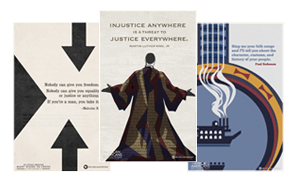Civil Disobedience and Social Change ~ Lesson Plan
Lesson Overview
(Click here for a printer-friendly version of this lesson).
LESSON TITLE: Calculated Acts: Civil Disobedience and Social Change
GRADE LEVEL: 7-9
TIME ALLOTMENT: Two 45-minute class periods (excluding homework time)
OVERVIEW
In this lesson, students will explore civil disobedience as a tool for social change, focusing specifically on Homer Plessy’s 1892 refusal to leave a “whites only” train car in New Orleans, which led to the landmark Supreme Court case Plessy v. Ferguson. The lesson will begin with a brief examination of other acts of civil disobedience in American History, after which students will develop a definition for the term. Next, students will examine some of the post-Civil War legislation that led Homer Plessy’s arrest, and view a segment of the PBS series The African Americans: Many Rivers to Cross to develop further understanding of the case and its outcome. Finally, students will research and report on other acts of civil disobedience, and assess whether or not these acts resulted in immediate societal changes, or were contributing factors in larger social movements over time. The lesson is best used in a larger unit on post-Civil War history, or as a precursor to studying the Civil Rights Movement of the 1950s and 1960s, in particular Brown v. Board of Education.
SUBJECT MATTER
Social Studies
LEARNING OBJECTIVES
After completing this lesson, students will be able to:
- Define the term “civil disobedience”;
- Provide multiple examples of civil disobedience American history;
- Describe some of the post-Civil War civil rights legislation that laid the groundwork for the act of civil disobedience central to the Supreme Court case Plessy v. Ferguson;
- Describe the key tenets of Plessy v. Ferguson and its outcome;
- Cite additional examples of civil disobedience in American history, and debate whether or not acts of civil disobedience are effective in isolation and/or against the larger sweep of history.
STANDARDS
From the Common Core Standards: English Language Arts
Common Core Standards, now adopted in over 40 states, are designed to help educators prepare students for success in college and careers by focusing on core knowledge and skills. The English Language Arts standards reflect the need for young people “to read, write, speak, listen, and use language effectively in a variety of content areas” including history/social studies. This curricular resource, developed to accompany The African Americans: Many Rivers to Cross aligns most closely with the following Common Core Standards:
RH.6-8.2. Determine the central ideas or information of a primary or secondary source; provide an accurate summary of the source distinct from prior knowledge or opinions.
RH.6-8.4. Determine the meaning of words and phrases as they are used in a text, including vocabulary specific to domains related to history/social studies.
RH.6-8.7. Integrate visual information (e.g., in charts, graphs, photographs, videos, or maps) with other information in print and digital texts.
From the National Standards for United States History for grades 5-12:
Era 6: The Development of the Industrial United States
Standard 2B: The student understands “scientific racism,” race relations, and the struggle for equal rights.
Grades 9-12: Analyze the arguments and methods by which various minority groups sought to acquire equal rights and opportunities guaranteed in the nation’s charter documents.
MEDIA COMPONENTS
Video
The African Americans: Many Rivers to Cross, Episode 3: “Into the Fire,” selected segment, accessed on the Video Segments Page.
Segment 1: A Calculated Act
An overview of Homer Plessy’s act of civil disobedience and the resulting Supreme Court case.
MATERIALS
For the class:
- Computer with Internet access, projection screen, and speakers (for class viewing of online video segment)
For each student:
- “Calculated Acts” Introductory Activity
- “The Road to Plessy v. Ferguson” legislation organizer
PREP FOR TEACHERS
Prior to teaching this lesson, you will need to:
Preview the video segment used in the lesson. Prepare to watch it using your classroom’s Internet connection.
Print out and make copies of the “Calculated Acts” Introductory Activity and the “Road to Plessy v. Ferguson” organizer for each student in your class.
Find educational resources related to this program - and access to thousands of curriculum-targeted digital resources for the classroom at PBS LearningMedia.
Visit PBS Learning Media






